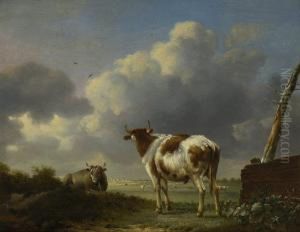Paulus Potters Paintings
Paulus Potter was a Dutch painter renowned for his detailed depictions of animals, landscapes, and rural scenes. Born in Enkhuizen, Netherlands, in 1625, into an artistic family, his father, Pieter Symonsz Potter, was also a painter, which provided Paulus with an early exposure to art. Potter moved to Amsterdam with his family in 1631, where he began his formal training and quickly developed a distinct style characterized by meticulous attention to detail and a keen observation of nature.
Potter's career, though brief due to his untimely death at the age of 28 in 1654, was prolific and impactful. He spent significant periods in Delft and The Hague, where he became a member of the painters' guild. His work garnered attention for its innovative focus on animals within the landscape, which were not merely accessories to human activity but were often the primary subjects of his compositions. One of his most famous works, 'The Young Bull' (1647), is a testament to this approach, offering a life-size depiction of a bull in a naturalistic setting, which was unusual for the time and highlighted Potter's mastery in rendering animals with accuracy and empathy.
Potter's influence extended beyond his animal paintings. He also produced a number of landscape works, characterized by their depth and realism, and contributed to the development of the Dutch landscape genre. Despite the brevity of his career, his oeuvre includes over 100 paintings, demonstrating a remarkable productivity and dedication to his art. Potter's work was highly regarded by his contemporaries and continues to be celebrated for its contribution to the Dutch Golden Age of painting. His ability to capture the essence of rural life and the natural world with such fidelity has ensured his lasting legacy in the history of art.
